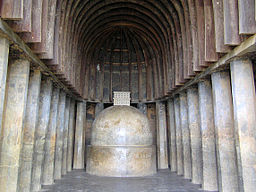Bhaja Caves
| Bhaje Caves | |
|---|---|

Stupa in the Chaityagrha, Cave XII
|
|
| Location | Bhaje, Maharashtra, India |
| Coordinates | 18°43′40″N 73°28′55″E / 18.72778°N 73.48194°ECoordinates: 18°43′40″N 73°28′55″E / 18.72778°N 73.48194°E |
| Geology | Basalt |
| Entrances | 22 |
| Difficulty | easy |
| Pronunciation | [Bhaja or Bhaje] |
Bhaja Caves or Bhaje caves (Marathi: भाजे) is a group of 22rock-cut caves dating back to the 2nd century BC located in Pune, near Lonavala, Maharashtra. The caves are 400 feet above the village of Bhaja, on an important ancient trade route running from the Arabian Sea eastward into the Deccan Plateau (the division between North India and South India). The inscriptions and the cave temple are protected as a National Monument, by the Archaeological Survey of India per Notification No. 2407-A. It belongs to the Hinayana Buddhism sect in Maharashtra. The caves have a number of stupas, one of their significant features. The most prominent excavation is its chaityagrha (Cave XII), demonstrating prototypes of wooden architecture and a vaulted horseshoe ceiling. Its vihara (Cave XVIII) has a pillared verandah in front and is adorned with unique reliefs. These caves are notable for their indications of the awareness of wooden architecture. The carvings prove that tabla – a percussion instrument – was used in India for at least two thousand years. The carving shows a woman playing tabla and another woman, performing dance.
The Bhaja Caves share architectural design with the Karla Caves. The most impressive monument is the large shrine — chaityagriha — with an open, horseshoe-arched entrance; according to the Archaeological Survey of India, the chaityagrha is the most prominent aspect of the caves, and one of the earliest of the type. The chaitrya has unique reliefs from Indian mythology. Other caves have a nave and aisle, with an apse containing a solid tupa and the aisle circling round the apse, providing the circumambulation path.
...
Wikipedia
